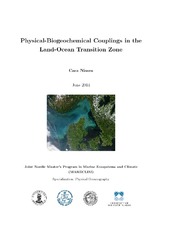| dc.description.abstract | A significant fraction of global primary production takes place on continental shelves. Due to their interactions with the open oceans, they are highly relevant for the cycling of nutrients, oxygen, and carbon, not only on a regional, but also on a global scale. Coastal areas are to a regionally varying extent impacted by atmospheric, oceanic, and terrestrial forcings, and benthic-pelagic coupling is especially important for the cycling of organic matter in these regions. In this study, the role of different processes controlling the benthic-pelagic coupling are assessed for the North and Baltic Sea, two regions of fundamentally different characteristics. While the North Sea is characterized by strong tides, exchange with the Atlantic Ocean, and no permanent stratification, the Baltic Sea is mostly influenced by freshwater runoff from land and a limited exchange with open ocean water masses, both leading to a permanent stratification of the water column causing frequent anoxia in the deep basins. The coupled hydro-dynamic-sea ice-NPZD-carbonate-model ECOSMO is used to quantify the role of dissolved and particulate fluxes across the sediment-water column interface for the cycling of nutrients, oxygen and carbon in both North and Baltic Sea by performing sensitivity studies. A new parametrization of sedimentary respiration is implemented accounting for the anoxic nature of sediments below a thin oxygenated surface layer, and the resulting nutrient and oxygen concentrations are opposed to the former parametrization and validated against observations. The new parametrization improves the model's performance in the Baltic Sea while the North Sea is insensitive to changes in the parametrization. Subsequently, the importance of resuspension for primary production is demonstrated. At first, the effect of resuspension on the nutrient availability is quantified, without including its effect on the light climate. Generally, the North Sea reacts more sensitively to neglecting resuspension which can be attributed to the stronger tidal forcing. Primary production is locally reduced by up to 45% thereby also significantly changing surface pH and surface flux of CO2. In a second step, the parametrization of light attenuation is changed to include light attenuation due to water, phytoplankton, dissolved organic matter (DOM), and detritus to address the effect of resuspended matter on light availability. The resuspension experiment is repeated with this new parametrization and results in a significant change in the seasonality of primary production. | en_US |
